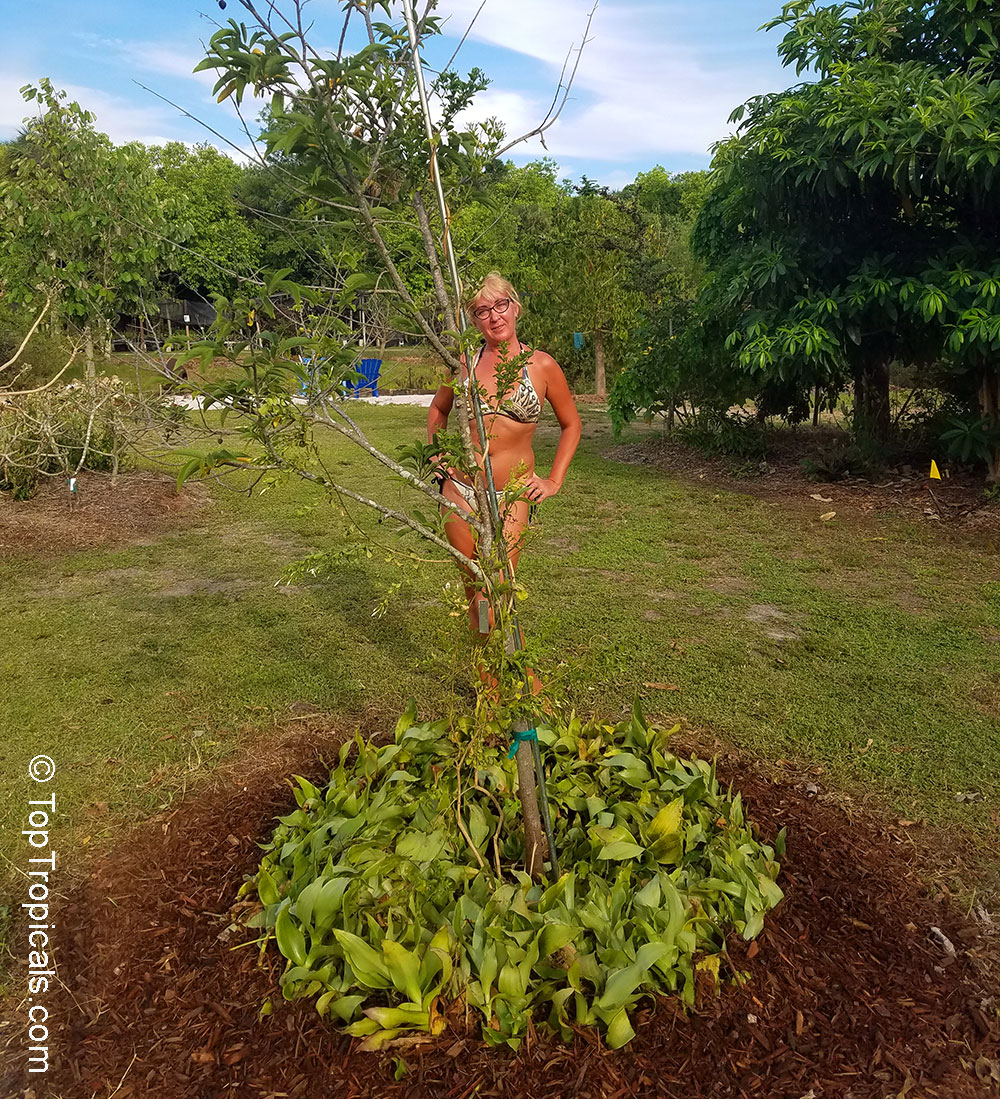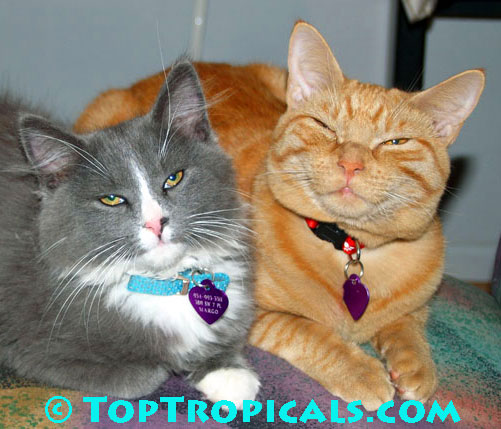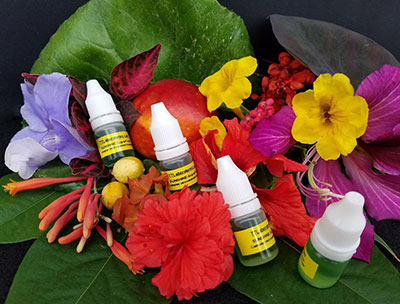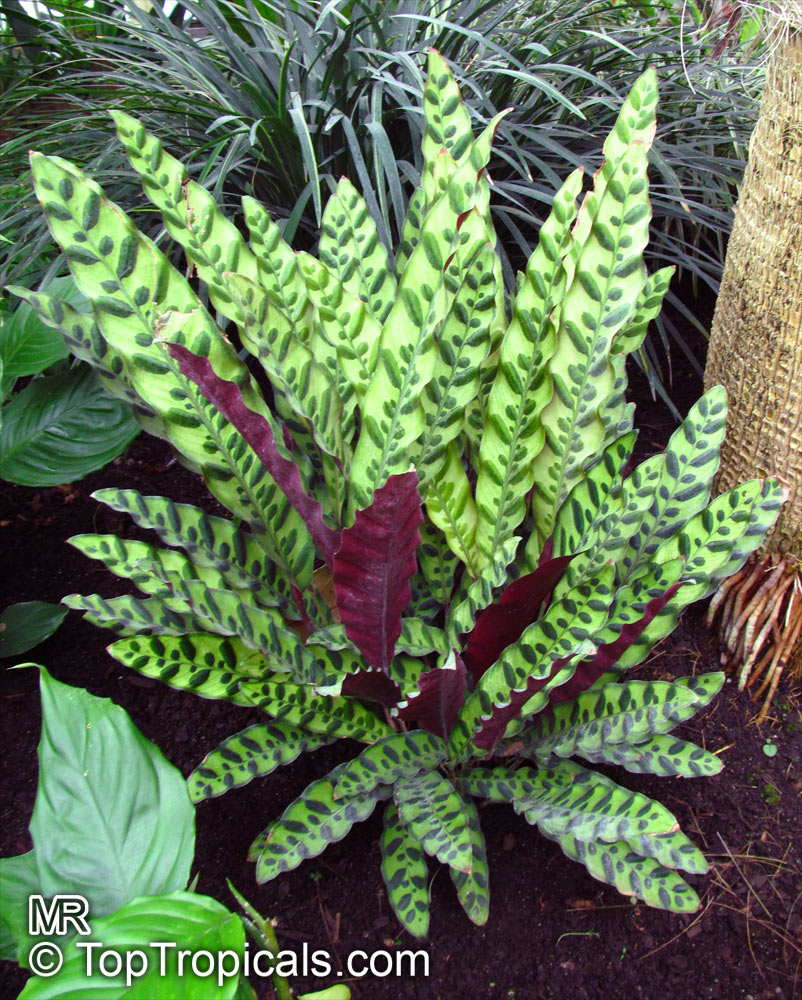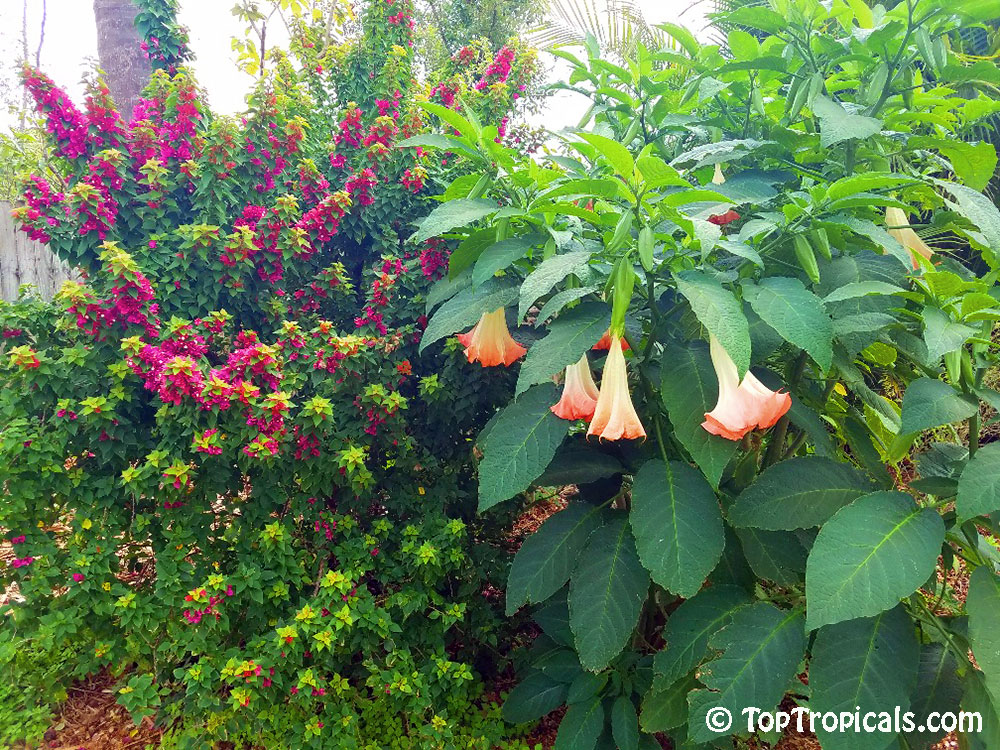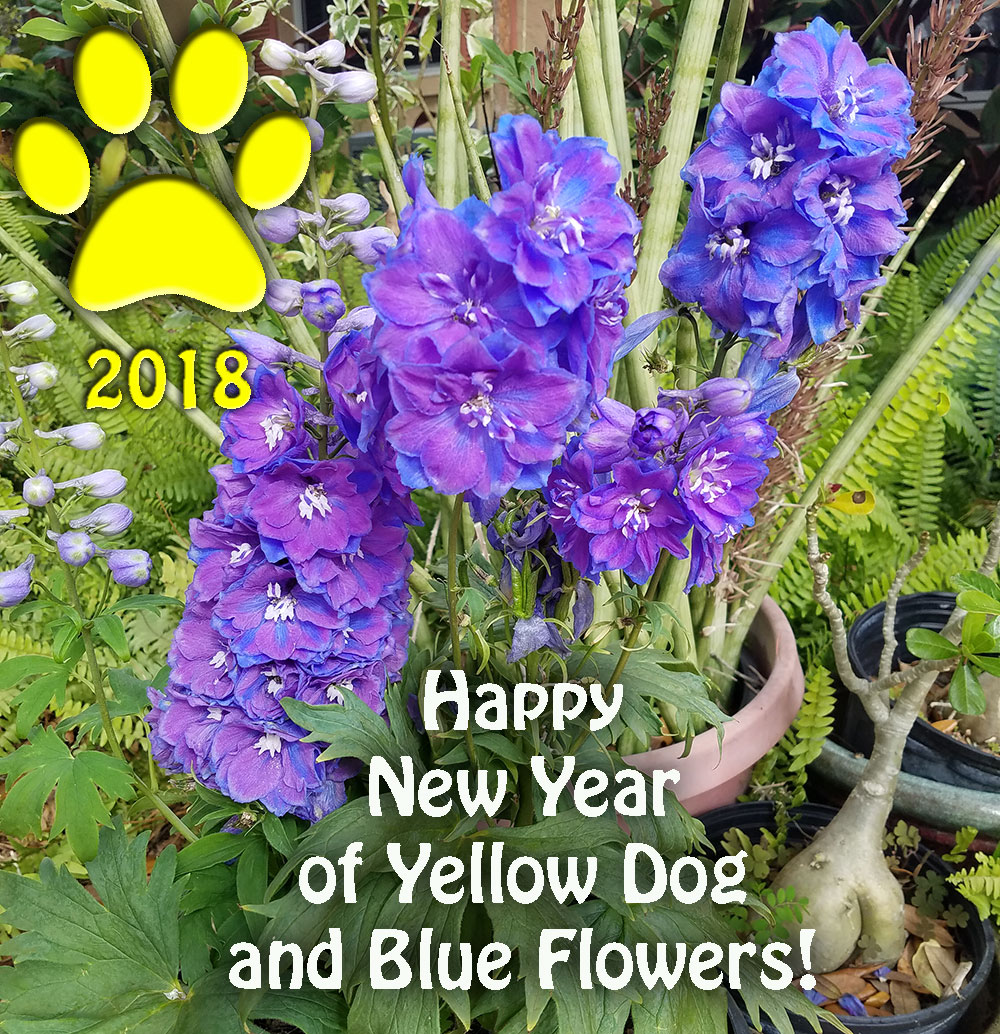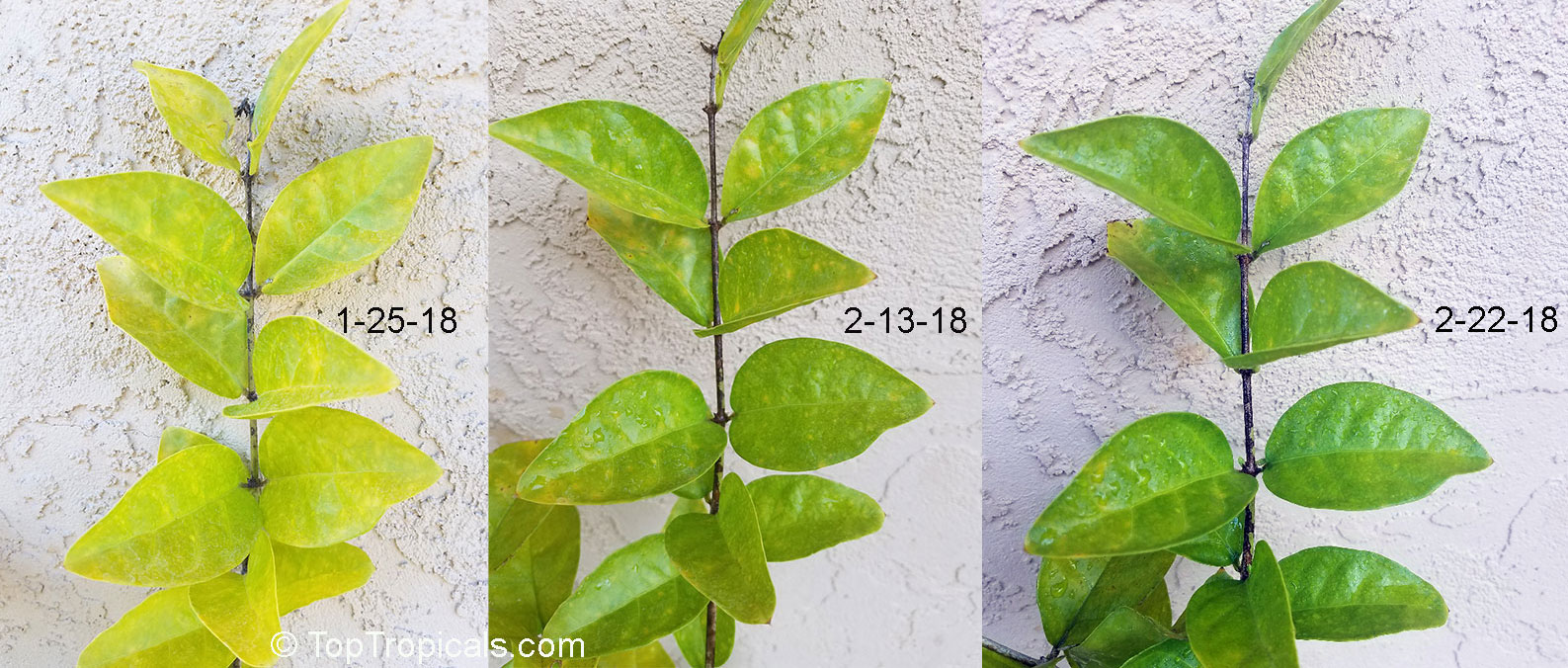Garden Blog - Top Tropicals
Date:
Overwintering tropicals indoors and air humidity
Q: My rainforest plant collection thrived outdoors in our humid summer (I live in Maryland) but of course I had to bring them indoors for winter and now with snow outside they are suffering. Some leaves dried and fell of. Please advise how not to lose my babies over winter!
A:
When overwintering tropical plants indoors, think about 3
factors: light, temperature, and humidity.
Light. Providing bright light is obvious, and all
indoor gardeners are doing their best to have as much
well-lit spots for their plants as possible.
TemperatureTropical plants, especially those from
rainforest, do not enjoy significant fluctuations in
temperature, so avoid following places: - neat hear
register (or air conditioning vent) - in drafts - on a
windowsill behind curtains at night
Humidity. Most tropical plants need more humidity
than is available in the average, centrally heated home,
but some rooms, such as bathrooms and kitchens, are more
humid than others. To created humidity, fill a tray that
is the same width as a plant, with pebbles or gravel. Pour
in water, keeping the level at just below the top of the
pebbles, then place your plant on top. The water will
produce humidity as it evaporates. Alternatively, mist the
leaves using a hand mister in the morning, so leaves dry
before night. If you have hard water, use distilled or
rain water. Grouping plants together will also increase
humidity.
Date:
Winter mulching in Southern landscapes
"My rule of green thumb for mulch is to double my initial estimate of bags needed, and add three. Then I'll only be two bags short." (Author unknown)
Q: What is the best time for mulching in Florida? What type of mulch do you recommend and how much should I use?
A:
Every gardener knows that spreading mulch in the garden
helps to protect the soil in general, prevents weeds from
growing, plus it has specific benefits during harsh winter
conditions. A layer of mulch will keep the soil insulated,
roots protected from possible freezing, so you'll also end
up with better results in spring by laying down mulch in
the cold months.
When? We lay mulch in our Florida garden right
now. It is cool so we work twice more efficient. After
rainy summer-fall season, most of mulch around plants had
broken down and in many areas soil is exposed: easy target
for weeds.
In general, in warm climates Fall and Winter mulching is
the most effective. Mulch creates an insulating barrier
between the soil and air, thereby protects plant roots
from rapid fluctuations in soil temperature.
How much? There is never too much mulch. Just make
sure to put it 2-3 inches away from the trunk to prevent
rotting and mold.
What kind? Different types of mulch can be used,
including wood chips, shredded leaves, straw and hay. Yes,
leaves and hay too! Remember all green parts of a plant (=
your leaves and grass) are full of Nitrogen so important
for plant vigor, it eventually will go back into the soil
as extra benefit. Unless you want to spend a fortune on a
fancy red or cypress mulch, you may use these natural
materials that are handy in every garden. After raking
leaves, pile them up and in couple weeks of drying and
breaking down leaves will become a perfect, soft mulch
that is best to use around fragile and herbaceous plants.
After mowing your lawn, save the cut grass and use the hay
as mulch. It always works the best in our garden, keeps
weeds away better than wood chips, and in spite of a
common belief that cut grass is full of weed seeds, we
never seen grass or weeds sprouting from that hay.
Happy mulching and stay warm!
Date:
"Happiness held is the seed; Happiness shared is the flower." (John Harrigan.)
Q: Our growing season is very short so I decided to start some of tropicals from seed indoors. When should I start?
A:
It is always a good time to start from seed. If you want
to feel happier, get into gardening. If you want to feel
God, start plants from seeds and watch New Life grow from
a tiny grain.
Traditionally, people prefer sowing seeds in Spring,
especially temperate species for vegetable garden:
tomatoes, peppers, cucumbers... My grandmother up North
started them in early Spring in small pots on a
windowsill, then once the temperatures raised just above
freezing, she planted them out in garden beds, and that
early start always helped her to have the best early
harvest in the neighborhood.
When we deal with tropical plants, "just above freezing"
is not warm enough. Which means, you have to grow small
babies indoors for quite a while, providing additional
heating when needed. Heating pads always work best... When
we had large size monitors and TV's, I always put couple
trays on top of hot monitors, and even on warm top of a
refrigerator, if space by the radiator was all taken. But
that was in very cold apartment...
If you keep your living space around 75F (ideal for many
species), this is a perfect temperature to get your seeds
started. Tropical plants are not like annual tomatoes that
try to grow through the season as fast as possible. They
may take time. So the sooner you start, the more chances
to get small seedlings just in time when Spring air
outside is warm enough - at least in 70's.
A great advantage of starting tropical seeds indoors is
controlled temperature and moisture. In the plant world,
environment extremes are not good for germination process.
Mild conditions of your home or a greenhouse create better
chances for successful growth. Seeds won't get overheated
in hot Summer sun, and won't get rotten because of a
sudden heavy rain. Just keep in mind that some species
require light for good germination.
Conditions for the best seed germination:
- Soak seeds for a few hours. Adding a few drops of Sunshine Seed Germination booster
is very beneficial and improves germination rate by 30-50%
- Well-drained mix, you may use our Professional Seed Germination Mix.
Put seeds not too deep (1/2 inch deep or less) to allow
air circulation
- Keep warm (75-85F) and in bright light
- Keep soil slightly moist but not soggy.
See more info on seed germination
Check out our seeds selection.
Date:
January 24 is Global Belly Laugh Day!
"Humor is laughing at what you haven't got when you ought to have it." (Langston Hughes)
January 24 is Global Belly Laugh Day! Celebrate the Great Gift of Laughter, smile, throw your arms in the air and laugh out loud. Laughs and smiles are sunshine that transform our moments 24 hours a day, on the 7 continents! Let's honor this week's high-spirited holiday by celebrating the chuckle.
To make you laugh and smile even more, here is a 15% off
your entire purchase!
use
this code: LAUGH2018
Offer expires end of Thursday, January 25. Min order $50
before S&H.
Laugh, get what you want and get it shipped to you for FREE!
Date:
New 2018 release: SUNSHINE SuperFood
"Two out of every five people on Earth today owe their lives to the higher crop outputs that fertilizer has made possible." (Bill Gates)
Micronutrient Supplement and Plant Health Booster
Misshapen, small fruit or no fruit?
Poor root growth?
Pale or yellow leaves?
Die backs?
Curled leaves?
Slow growth?
Don't let your plants starve... SUNSHINE SuperFood is your
answer to all these problems!
Read more why your plants need
SUNSHINE-SuperFood - Essential Element Complex that
has them all: N-NH2, Mg, Fe, Mn, Zn, Cu, B, Mo, S...
SUNSHINEâ„¢ SuperFood is a revolutionary new product
released in 2018. It is a super micro-element supplement
(Amino Acid Chelated Micronutrient) containing
microelements, ultra-microelements, glycinates, as well as
SUNSHINE-Honey ingredients.
It shows amazing results in plant development, treating
different element deficiencies, and improving fruit trees
production.
GREEN-EARTH-ECOLOGY FRIENDLY! And it is GREEN color!
Buy SUNSHINE Superfood... item # 6000!
Date:
Full Sun Garden vs Shade Garden
"Someone is sitting in the shade today because someone planted a tree a long time ago." (Warren Buffett)
Q: I live in California and I have a large area of my garden in full shade. Are there any plants that will be happy there? I am looking for something colorful. I also have a smaller area in front of the house that has full sun almost all day long, but I am afraid this can be too hot for flowering plants? Can you recommend something?
A:
Full sun gardens have a strong, bright look while shade
gardens have cooler, subdued appearance. Both types of
gardens are fun to design and maintain as long as you pick
the right plants.
Full Sun Garden is the easiest to grow. Depending
on exposure, it may require some plants that can tolerate
the hottest summer days and the dry conditions in your
area. The good news is, the majority of tropical and
subtropical plants prefer full sun, so you have a large
selection to pick from - fruit trees, flowering trees,
shrubs, vines, and small perennials. The more sun, the
more flowers and fruit you will get! However, keep in mind
that sun gardens require more water, but generous mulching
will help to minimize watering.
Shade Garden is much more restful in appearance,
but sometimes may be a little more difficult to work with.
As shade trees grow bigger and thicker, it may become too
dark; nothing will grow in total darkness. In this case
you need to prune back some branches to let more light in.
Filtered sunlight or dappled light coming through the
leaves of the trees is beneficial and considered light
shade, which would be the best light conditions for shade
loving plants to thrive. Although shady cooler spaces
attract more insects and will require more attention to
control them, they also have some advantages over sun
gardens. You can enjoy working in cooler conditions, and
your garden will require less water. Many foliage plants
look more deeply colored and healthier than in full sun;
white flowers shine instead of looking washed out!
Our favorite shade plants are fragrant brunfelsias , clerodendrums, and of course
colorful gingers and heliconias. You
may also consider ornamental foliage of Calatheas, lush Alocasias, Colocasias, and colorful Cordylines. Check out our shade loving plant list for
more colorful suggestions. These are also great for indoor
gardens!
Date:
Spring is coming, plants need food! Time to fertilize...
Last winter was long and snowy in the most part of our
country. Hold on fellow gardeners up North, it is almost
over!
Here in Florida we have been blessed again with a mild
winter without serious cold snaps. Early Spring that is
already in the air. Look at this picture of flowers in our
front yard now.
If the weather is already warm in your area (low
temperatures above 55), it is time to start fertilizing.
We are sending our love and support to tropical Puerto
Rico suffered from hurricane last year, and will be happy
to help you guys to restore your lost gardens!
CHECK LIST
what
to do to give your garden a good kick start:
1. Slow release granulated food. Apply Slow Release Fertilizer and
continue once a month. 1 tsp per gallon of pot, or a
handful for in-ground plants. This will provide essential
macro elements (NPK) required for a plant growth.
2. Water soluble micro-elements. Besides
macro-elements, plants need many other elements that most
of the time missing in soil. A lack of micro-elements
causes different deficiencies, resulting in weak root
systems, slow growth, deformed leaves, leaves yellowing,
lack or no flowers/fruit. Apply these supplements as a
foliar spray once a month to induce healthy growth and
flower/fruit development. We recommend the following
micro-element products to keep your plants healthy and
vigorous year round:
a) SUNSHINE SuperFood - plant
health booster. This revolutionary new liquid complex
contains ALL microelements needed and can fix all possible
problems occuring to your tropical plants - from roots to
flowers and fruit. We have convenient dropper bottles of 5 ml for small plant
collections, 50 ml for larger gardens, and
100 ml for professional
landscape applications.
b) SUNSHINE-Micro - Microelement
booster - for common iron deficiency (pale leaves)
c) SUNSHINE-Super-Iron -
Microelement booster - for severe iron deficiency
(severe yellowing leaves)
3. SUNSHINE plant boosters -
SUNSHINE-E, -BC (caudex plants and bonsai), -H (house
plants). Apply these natural plant stimulants to
help plants recover from cold, dormancy, increase plant's
metabolism and make a plant more readily absorb both
Macro- and Micro-elements. SUNSHINE boosters also will
help plants grow vigorously, withstand Summer heat and
drought, and produce bigger and better flowers and fruit.
4. Kickstart a sweeter fruit. To get a better and
sweeter crop in Summer and Fall, you need to start first
application now. SUNSHINE Honey - is natural,
Amber-colored, honey-like liquid microelement product for
fruiting and edible plants that will make them sweeter,
tastier and more flavorful! Very effective for tropical
fruits, tubers, vegetables. Great for tropical fruit
trees: Mango, June Plum, Annonas, Tropical Cherries,
Carambola, Citrus; subtropical fruit trees: Peaches,
Apricots, Loquat and berry plants (blackberry, mulberry,
etc.)
5. SUNSHINE-S. Don't
forget to plant seeds! It's a perfect timing
now to start your tropical garden indoors even if it is
still cold outside. Soak them in SUNSHINE-S solution to
increase germination rate.
See full list of SUNSHINE boosters.
All these products are essential plant elements. They are
not toxic and can be used safely for edible landscapes.
Date:
How to keep your plants green
We continue experimenting with a new plant health booster SUNSHINE SuperFood. Couple weeks ago we grabbed a very sad looking jasmine with completely yellow leaves... It suffered from winter cool night temperatures plus some overwatering that caused weak roots and due to that - a number of deficiencies. The plant looked pretty hopeless as far as turning yellow leaves back to green. The best bet to revive it was to cut it short, remove old leaves and wait for new healthy growth... but we decided to try SuperFood. And it worked! Since the plant was almost hopeless, we put it in a far corner and forgot about it. Imagine the surprise when we looked again and it was green! See full plant photo of this jasmine.Try SUNSHINE SuperFood on sick
looking plants, especially with yellowing and/or deformed
leaves. There are no miracles, but this one works a like a
Miracle! All you need is a few drops of SUNSHINE SuperFood - item 6000!
Read more about SUNSHINE
SuperFood...
Date:
Asian New Year started! Year of Down to Earth Dog...
Chinese New Year, also known as the Spring Festival, started on February 16, 2018. It is the Year of the Yellow Dog, or the Earth Dog.
According to Chinese horoscope, in 2018, the
corresponding element is Earth. Earth is also associated
with the color yellow. The Year of the Earth Dog is
therefore also known as the Year of the Yellow Dog. So
what happens when you mix the Dog with the Earth Element?
The Dog is sincere, independent, and clever. Like man's
best friend, they are extremely loyal and devoted and you
can always count on them to stick by your side.
The Earth element, by its very nature, denotes origins and
growth and is associated with practicality, harmony and
hard work. The Earth seeks to nurture and be nurtured, it
anchors you and provides stability.
A loyal and hard working Dog combined with the steady and
sensible characteristics of Earth, heralds a secure,
rewarding and profitable year. A year of blossoming, to
achieve things, and to thrive. An Earth Dog combines the
integrity and diligence of the dog with a very
"down-to-earth" climate, perfect for longstanding projects
requiring persistence and grit. Real estate is high in the
agenda in the year of the Yellow Dog, whether you are
contemplating any investments or purchasing a home,
everything should align well for you this year.
The Year of the Dog follows an energetic and chaotic Year
of the Rooster... An Earth Dog Year will welcome some much
needed sense of harmony, peace and goodwill, a year of
unity and understanding that will reward all of us for our
hard work and diligence!
Lucky colors for 2018 are colors that symbolize the
element Wood (green) and the element Water (blue). Just
keep your plants green, and get some blue flowers!
For more information on Plant Astrology, see Plant Horoscope.
Date:
SUNSHINE-SuperFood for your plants health
We are getting very high interest from our customers to our new plant booster SUNSHINE-SuperFood as well as many questions. We continue experimenting with the Jasmine that you saw in our previous newsletter, that had pale yellow leaves and numerous deficiencies. Right now, after only 2 applications, it looks healthy green again. Click on the picture to zoom in and see leaves turning from yellow to green within less than a month. See also full plant photo of this jasmine.
Q: Is SUNSHINE-SuperFood a fertilizer?
A: Traditionally we call a fertilizer macro-elements (NPK - nitrogen, phosphorus, and potassium). Technically, SUNSHINE-SuperFood is a complex of micro-elements that are essential for plant's health. It provides such elements as Mg, Fe, Mn, Zn, Cu, B, Mo, S, and Amino-acids that our soils are usually poor of. These elements are responsible for proper development of leaves, roots, flowers, and overall plant vigor. Read more about role of these micro elements.
Q: Can I just get these additional elements in a dry form and add to soil like a fertilizer?
A: No. Some of these elements must present in extremely low concentrations (this is why they are called micro-). SUNSHINE-SuperFood is a liquid substance with very high bioavailability that has very complicated formula; it is not just a mix of the elements. The formula is developed with the maximum efficiency for a plant to absorb through leaves and a root system.
Q: Is it better to spray leaves or water the plant with the solution?
A: Foliar applications are always most efficient in regards of seeing a quick result. However, we recommend to also drench the root ball with SUNSHINE-SuperFood solution to deliver the necessary elements evenly to all parts of the plant through its natural metabolism.
Q: My gardenia looks very sad after winter - most leaves are yellow and some have pale spots. Should I use SUNSHINE-SuperFood more often and in higher concentrations?
A: We recommend to apply SUNSHINE-SuperFood once a month to maintain a general plant health. In difficult cases like with this jasmine on the photo, you can do twice a month. However do not exceed recommended concentration. The rule of thumb is, you can apply water soluble fertilizers and supplements more often, but with lower concentrations - this way a plant will be more responsive. Plant metabolism in general is rather slow, changes take days and weeks - don't try to speed it up. Your patience will be rewarded.
Try SUNSHINE SuperFood on sick looking plants, especially with leaves that are yellowing, deformed or have spots (see photos of different deficiencies). There are no miracles, but this one works like a Miracle! All you need is a few drops of SUNSHINE SuperFood - item 6000! We also have bottles 50 ml and 100 ml for large plant collections and yard/landscape applications. Read more about SUNSHINE SuperFood...
